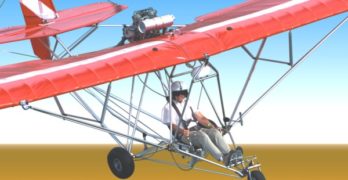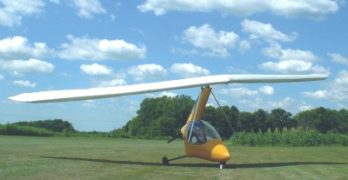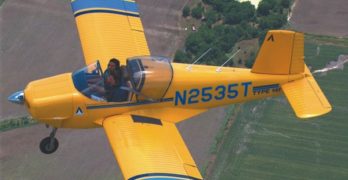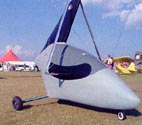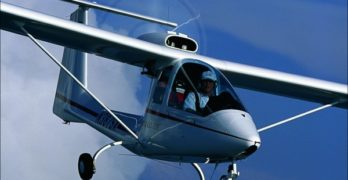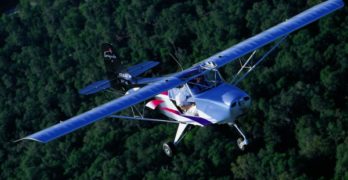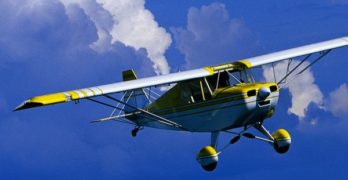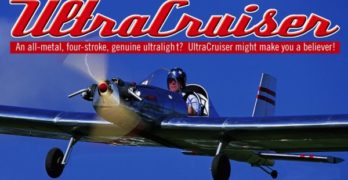Twenty-something years of ultralight flying have seen many changes take place in our ultralights. At the beginning of the ultralight industry we had craft such as Eagles, Weedhoppers, and Quicksilvers powered by engines like the 15-hp Yamaha, Mac 101, and Chrysler. Of these, only Quicksilver remains vibrant.
Here in 2004, we have aircraft like the Breese DS with its 60-hp HKS 700E 4-stroke engine. It may look like a Quicksilver but it’s a different flying animal. M-Squared’s Jay Stevens gave me a checkout in the single-seat Breese with its Japanese 4-stroke powerplant and it proved to be a very satisfying experience.
Strong and Powerful
The resemblance to Quicksilver, especially the California company’s strut-braced model, is obvious to most ultralight veterans but Breese manufacturer M-Squared has steadily changed their design. Looks, therefore, can be deceiving.
The use of struts first set apart the designs of Paul Mather, proprietor of M-Squared. A tailplane that uses no cable bracing added to the different appearance.
Search Results for : CT AND hand control
Not finding exactly what you expected? Try our advanced search option.
Select a manufacturer to go straight to all our content about that manufacturer.
Select an aircraft model to go straight to all our content about that model.
Seagull Aerosports takes a new angle
Seagull Aerosports takes a new angle on weight-shift construction with a fully enclosed cockpit.
Developer Michael Riggs might prefer I called his Escape Pod something other than Everyman’s Motorglider, but if you have any interest in self-launched soaring flight, Riggs’ invention is one of the most cost-efficient purchases you can make. The Escape Pod costs thousands less than ultralight motorgliders and literally hundreds of thousands less than sailplane motorgliders.
Oh, and one more thing this kind of flying machine is a hoot to fly. That the Escape Pod also transports easily, can be stored in a small space and is attractively shaped are icing on the cake.
Sure, it’s obvious-I like the Escape Pod. But could it be for you, too? Even if this aircraft isn’t your type, you might enjoy reading about how thoughtfully it was designed.
Trike Motorgliders
Before the Sport Pilot/Light-Sport Aircraft (LSA) rule was recently passed, trike enthusiasts had several other ways to fly such aircraft.
Thorp T-211
Thorp T-211 Sport E
From the world of general aviation aircraft comes an entry to the proposed Light-Sport Aircraft (LSA) category. Presently known as the Thorp T-211, the all-metal airplane will be called the Thorp T-211 Sport E when it makes its debut as a light-sport aircraft.
Famed designer John Thorp is perhaps best known for his work leading to the Piper Cherokee series and the T-18 homebuilt. His work on a design that became the T-211 started back in the 1940s before general aviation planes had transportation as their primary goal. When the T-211 was first created – as the T-11 Skooter and later the T-111 – it was intended to become competition for the Cessna 150. The T-211 is a light plane, tipping the scales at hundreds of pounds less than Cessna’s smallest model and so it was expected to perform better.
Under new management since 2003, Thorp’s design is ready to make the leap to the Sport E.
Part 103 Ultralight Trikes
Part 103 ultralight trikes aim at soaring pilots.
Many visitors to Oshkosh AirVenture 2003 expected the FAA to announce its new sport pilot/light-sport aircraft rule. New Administrator Marion Blakey reported signing off on the rule on July 30, but with two other agencies in line to review it, we aren’t likely to see the final version until 2004.
Visitors may not have expected to see more than a few Part 103 ultralight aircraft at AirVenture (some thought they would disappear as LSA approaches). But there were many. Next month I’ll write about two Part 103 rotary-wing aircraft, but this time, the subject is nanotrikes.
Nanotrike is a term to describe extremely light wheeled structures combining powered paraglider engines and contemporary hang glider wings. The idea is to create a low-cost, self-launching ultralight motorglider.
Trike Pod
Minnesota-based Seagull Aerosports debuted its Escape Pod at Oshkosh. Pushed by a single-cylinder Cors-Air engine generating 25 hp, the Escape Pod weighs only 75 pounds.
Tuning Up Skystar
SkyStar reorganizes to offer ultralights, homebuilts and special LSAs under “one” roof.
For the new SkyStar Aircraft Corp., the light at the end of the proverbial tunnel is not a locomotive; it’s the coming of a bright new day in light aviation. As the publication of the final sport pilot and light-sport aircraft (SP/LSA) rule looms on the horizon, business is looking better for SkyStar and most other manufacturers and suppliers of light aviation equipment.
The two-place SkyStar Series 7 will have multiple personalities. SkyStar Sport Planes will manufacture a variation of this model as a ready-to-fly special LSA. Depending on the parameters of the final rule, SkyStar Sport Planes may sell an experimental LSA kit (more than 51-percent complete). When flown as an LSA, the Series 7 will be limited to the Rotax 912S engine as its powerplant. SkyStar Aircraft will continue to offer the Series 7 as a 51- percent amateur-built kit, with a variety of engine options, including the 914 Turbo version shown here.
Shooting Across the Sky
Italy’s Sky Arrow makes its mark in the United States
Just as it is home to many fine sports cars, Italy is also home to some beautiful light aircraft-the Sky Arrow being one. The tandem two-seat airplane is designed and manufactured there by Iniziative Industriali Italiane S.p.A (III). Formerly known as Meteor, the company was started in 1947 and also manufactures gliders, airplanes, and remotely piloted vehicles.
Pacific Aerosystem Inc., of San Diego, California, is the United States importer of the Sky Arrow line. With more than 200 Sky Arrows flying worldwide and 25 in the United States, III is an experienced manufacturer and able to meet customer needs, reports Pacific Aerosystem, an important factor to consider when choosing an aircraft.
Currently, Pacific Aerosystem sells four ready-to-fly versions of the Sky Arrow. A kit version can be built under the experimental amateurbuilt rule. Powerplants and instrumentation delineate the models. An 80-hp Rotax 912 powers the 650 TCN and 560 T models.
Relive the World War II fighter experience
The Ending
In the remainder of this article I’ll tell you what I thought of this new offering from Titan Aircraft, the successful builder of the Tornado line of ultralights and light aircraft. But I must be forthright and tell you my hour and a quarter flight with this new airplane ended with a landing on its belly.
I rush to say it wasn’t simple forgetfulness; I didn’t forget to put the gear down. Instead, a simple mechanical problem in this prototype T-51 prevented the retractable gear from fully extending. The gear was partially down, but it refused to lock in position. A post-incident investigation revealed that a tiny activation pin broke off the gear-down microswitch when I tried to activate it with too forceful a movement. Because the micro-switch didn’t activate, the hydraulic system didn’t push the gear legs down all the way.
Considering the gear was down only about 50 percent, according to Titan President John Williams who was watching from the ground, my touch down was remarkably smooth, and the T-51 rolled for quite a few yards.
On An Escapade
Just Aircraft’s Excapade … certificated in England and ready for sport pilots!
Southwestern Idaho has long been a hub of aircraft activity. With ranches and towns settled in great distances, it’s not surprising that aviation, once an established mode of transportation, quickly became popular in that part of the west. It’s also not surprising, then, that the area has been a hub of aircraft building activity. Here’s the story of one aircraft that’s evolved from that heritage.
In 1983, a two-seat, steel tube and fabric aircraft called the Avid Flyer made its first appearance at EAA’s annual convention. Describing the new design in the October 1983 issue of EAA Sport Aviation, then editor Jack Cox wrote, “Dan Denney of Boise, Idaho, was the person with the idea from which sprang the Avid Flyer. He wanted ‘something between ultralights and homebuilts’|(and) Dan had a friend uniquely qualified to transform that (idea) into|an airplane, Dean Wilson.”
What Denney and Wilson demonstrated to the fly-in crowd that year might be called the forerunner of the pending light-sport aircraft category|even at a time when ultralights were still gaining their foothold.
Hawk looks Good in Wood!
Not all Light-Sport Aircraft will be composite.
Beautiful imported aircraft like the CT2K, Mirage, Jabiru, or Kolb Sport seem to best represent what many pilots imagine when they hear the words “light-sport aircraft.” These shapely composite designs are speedy and modern looking. Yet we’d be foolish to ignore the entire fleet of amateur-built light-sport aircraft (LSA) candidates. One of these is Fisher Flying Products’ Dakota Hawk.
Wood Still Works!
The Dakota Hawk is a simple, wood-structure light aircraft covered in fabric. Sound familiar? Sound comfortable and well understood? You bet it does.
While the Dakota Hawk may not be seen as a “modern” design, neither is it a vintage aircraft like Fisher’s fascinating Tiger Moth replica. Instead, most pilots probably link the Dakota Hawk to a golden era of general aviation when Piper Cubs, Taylorcrafts, and Luscombes were the darlings of light flight.
Regardless of what regulatory program it operates under, this high-wing taildragger is a sweet flier that will address what many pilots want out of aviation.
All-metal, Four-stroke, Genuine Ultralight
The new light-sport aircraft (LSA) category will soon be a reality. While a best guess is that FAA’s newest rules could be announced at EAA AirVenture Oshkosh later this month, it may happen later in the year. Whenever it happens, and like many others watching closely, I hope this new concept arrives swiftly with its promise of interesting aircraft at affordable prices.
As important as LSA may be, however, the proposed new the rule doesn’t affect other enjoyable flying machines. Aircraft built under the amateur-built (51-percent) rule will continue to be a major factor. Many EAA members are building under this rule, and these aircraft will continue to offer wide choices, performance beyond that of many general aviation aircraft, and the pride of craftsmanship. LSA also leaves room for Part 103 ultralights to continue and grow. While some industry leaders see little demand for single-seat aircraft powered by small engines-and it is true that they do not make up a majority of machines-neither, however, will they disappear.
- « Previous Page
- 1
- …
- 48
- 49
- 50
- 51
- 52
- …
- 61
- Next Page »


